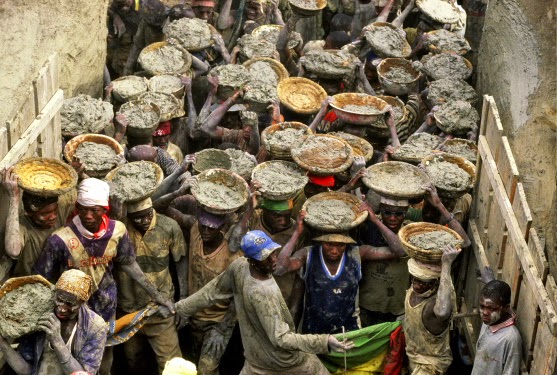Marketplace
Marketplace
Marketplace
THE GREAT MOSQUE
The Building of the Great Mosque
Running time for this section starts at 10:09 (begin video there)


Running time for this section starts at 10:09 (begin video there)

The Great Mosque of Djenné is a large banco or adobe building that is considered by many architects to be one of the greatest achievements of the Sudano-Sahelian architectural style. The mosque is located in the city of Djenné, Mali, on the flood plain of the Bani River.

DESIGN
The walls of the Great Mosque are made of sun-baked earth bricks (called ferey), and sand and earth based mortar, and are coated with a plaster which gives the building its smooth, sculpted look.
The walls of the building are decorated with bundles of rodier palm (Borassus aethiopum) sticks, called toron, that project about 60 cm (2 ft) from the surface.
The toron also serve as readymade scaffolding for the annual repairs. Ceramic half-pipes also extend from the roofline and direct rain water from the roof away from the walls.
CULTURAL SIGNIFICANCE
The entire community of Djenné takes an active role in the mosque's maintenance via a unique annual festival.
This includes music and food, but has the primary objective of repairing the damage inflicted on the mosque in the past year (mostly erosion caused by the annual rains and cracks caused by changes in temperature and humidity). In the days leading up to the festival, the plaster is prepared in pits. It requires several days to cure but needs to be periodically stirred, a task usually falling to young boys who play in the mixture, thus stirring up the contents.
Men climb onto the mosque's built-in scaffolding and ladders made of palm wood and smear the plaster over the face of the mosque.
Another group of men carries the plaster from the pits to the workmen on the mosque. A race is held at the beginning of the festival to see who will be the first to deliver the plaster to the mosque.
Women and girls carry water to the pits before the festival and to the workmen on the mosque during it.Members of Djenné's masons guild direct the work, while elderly members of the community, who have already participated in the festival many times, sit in a place of honor in the market square watching the proceedings.
UNESCO
In a fascinating session at Dumbarton Oaks’ latest conference on cultural landscapes in Sub Saharan Africa, Charlotte Joy, an anthropologist at University of London, delved into Mali’s convoluted history with UNESCO World Heritage program and one local community’s efforts to preserve a cultural landscape people still call home.
The United Nations Educational, Scientific, and Cultural Organization (UNESCO) was formed with the rest of the UN System in the mid-1940s. Its philosophy, said Joy, was always to “foster inter-cultural dialogue through education.” The idea behind the organization was to “construct peace in the minds of men,” not just through disarmament and economic development. The thinking was if cultures could better understand each other, they would go to war with each other less.
In 1972, after years of debate about what constitutes significant cultural value and the best ways to preserve the sites that embody it, UNESCO’s member states signed the World Heritage Convention and, six years later, formed the first World Heritage List. Today, the list, which includes some 962 sites, is seen as a critical tool for spreading knowledge about cultures.
The Great Mosque, 1910
SEE ALSO:








.jpg)

.jpg)

.jpg)





No comments:
Post a Comment